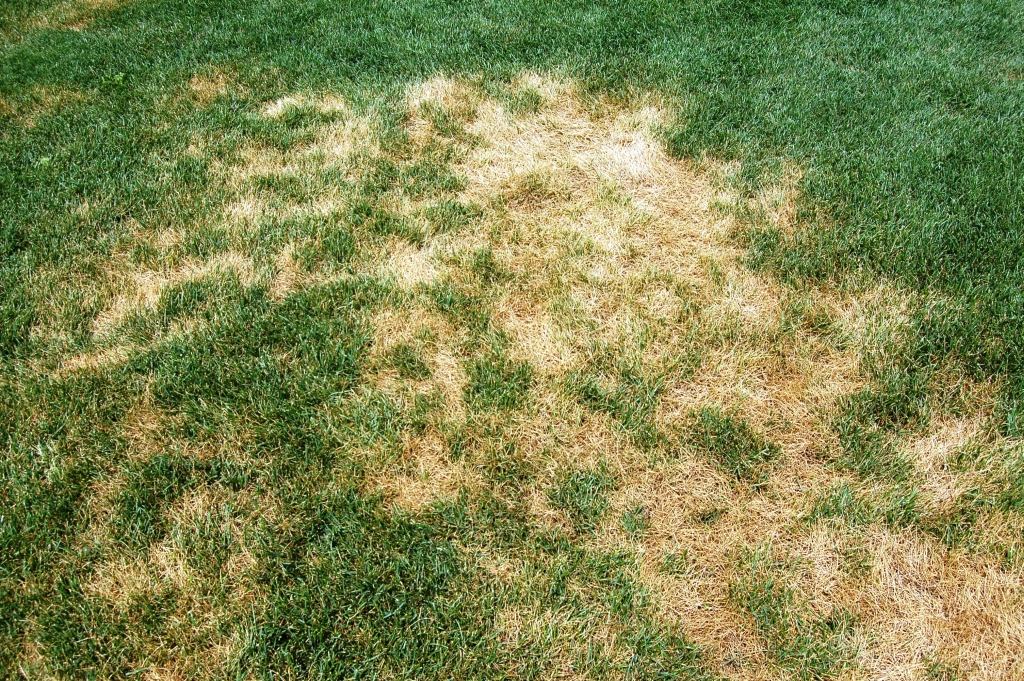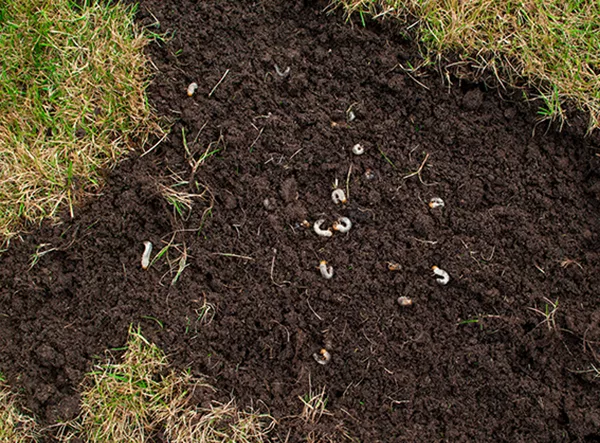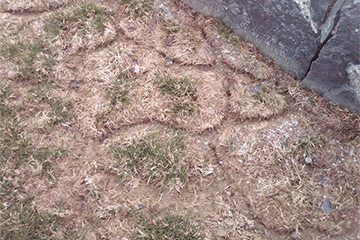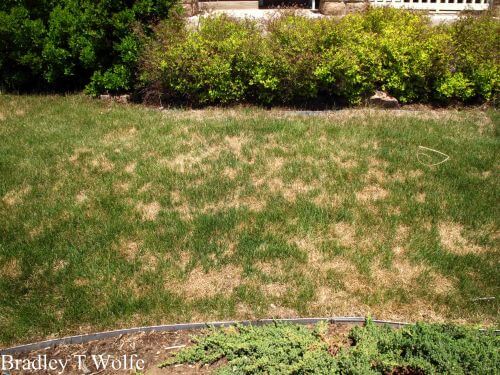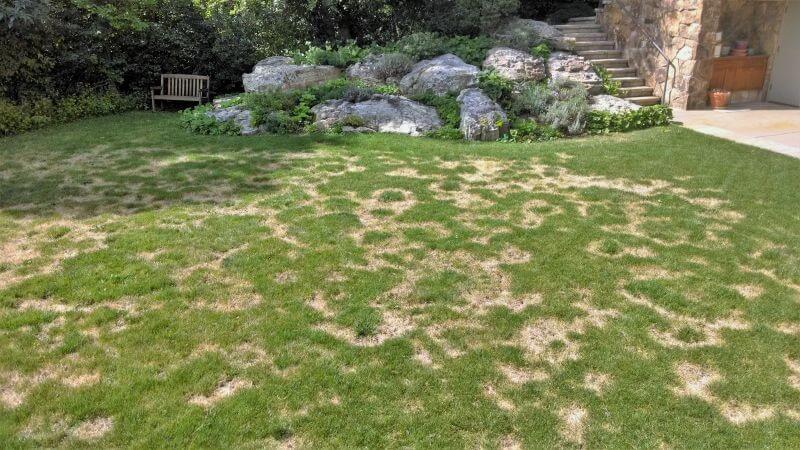LAWN DISEASE TREATMENT SERVICES
Common Lawn Diseases in Colorado?
Lawn Disease and Fungus Experts
At Organo-Lawn, our state-licensed lawn care professionals specialize in expert lawn disease diagnosis and treatment of difficult to control fungus problems. With years of experience, we accurately identify grass diseases and provide logical, effective solutions—without relying on potentially harmful fungicide treatments.
Common Lawn Fungus and Insect Problems of Colorado
In Colorado, particularly in the Boulder and Fort Collins areas, homeowners often face various lawn fungal diseases and insect infestations that can impact the health and appearance of their turf.
Most Common Lawn Fungus Issues
- Necrotic Ring Spot (NRS) – A destructive fungal disease that causes circular patches of dead grass with a yellowish “frog-eye” ring pattern. It thrives in compacted soils and is caused by excessive watering.
- Ascochyta Leaf Blight – A rapid-spreading fungus that leads to straw-colored, wilted grass with a drought-stressed appearance. A symptom of shallow digging grass roots and often triggered by improper watering or mowing practices.
Other Lawn Diseases Found in Colorado
While less common, these fungal diseases can also pose a threat to lawns:
- Brown Patch Fungus – Symptoms are irregular brown patches in humid or overwatered lawns.
- Dollar Spot Fungus – Appears as small, silver-dollar-sized patches of discolored grass.
- Powdery Mildew – Forms a white, powdery coating on grass blades in shady, humid areas.
- Pink and Gray Snow Mold – Develops in cool, damp conditions after snowmelt, leaving matted, dead grass.
- Melting Out – Leads to thinning turf and dark lesions on grass blades, weakening the lawn over time.
Necrotic Ring Spot
Lawn Fungus & Sprinkler System Issues: The Hidden Connection
Fungicides kill not only harmful fungi but also beneficial microbes that support soil health, making them counterproductive for long-term lawn disease control. Healthy soil microbes help break down organic matter, improve nutrient availability, and suppress pathogens naturally. When fungicides disrupt this balance, they weaken the soil’s ability to fight off diseases, leading to more recurring issues rather than solving the problem. Instead of relying on fungicides, focus on improving soil health through proper watering, aeration, compost applications, and microbial-rich treatments to create a naturally disease-resistant lawn.
Lawn Fungus & Sprinkler System Programming – The Hidden Connection
When a lawn fungus like Ascochyta or Necrotic Ring Spot appears, the root cause is often an improperly programmed sprinkler system. Overwatering, underwatering, or inconsistent watering patterns create stress conditions that weaken the grass, making it more vulnerable to fungal infections. Frequent, shallow watering promotes weak, shallow roots, while irregular watering cycles can cause drought stress, triggering fungal outbreaks. Instead of applying fungicides, adjusting the sprinkler schedule to deep, infrequent watering (such as the 1-2-3-2-1 method) will help strengthen the grass and naturally prevent disease.
Avoid Using Fungicides
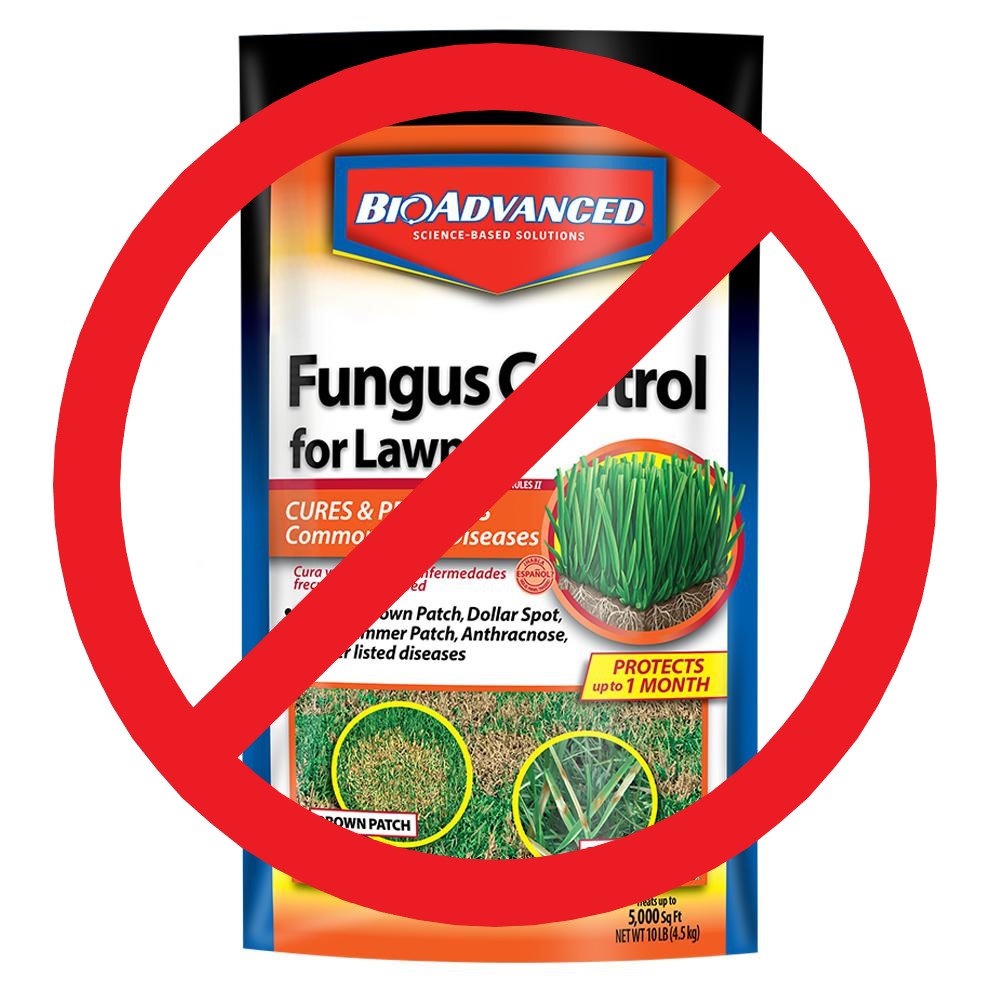
Common Lawn Insect Problems in Colorado
In addition to fungal diseases, several insects can damage Colorado lawns by feeding on grass roots, blades, and leaves, causing thinning turf and brown patches. The most common culprits include:
- Sod Webworms – Moth larvae that chew irregular brown patches in turfgrass.
- Clover / Spider Mites – Tiny, reddish-brown mites that cause silvery streaks and discoloration in grass.
- White Grubs (Japanese Beetle Larvae) – These root-feeding larvae destroy lawns from below, causing wilting, dead patches, and turf that lifts easily like a carpet.
Common Lawn Problems in Colorado
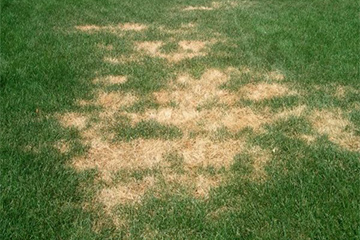
Ascochyta Leaf Blight the Summer Blight
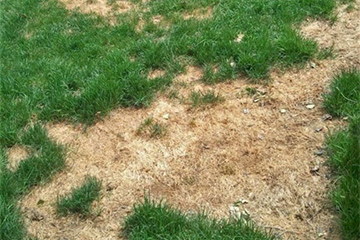
How to Prevent Dog Urine Damage
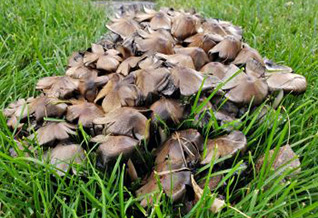
Mushrooms are they Good or Bad?
Protect Your Lawn with Expert Diagnosis & Treatment
Identifying the right fungal disease or insect issue is key to effective treatment and prevention. If you suspect lawn fungus, insect damage, or turf decline, contact Organo-Lawn for a professional diagnosis and eco-friendly treatment plan to keep your lawn healthy, lush, and resilient year-round!
Common Fungus and Diseases of Colorado Lawns
Ascochyta Leaf Blight a.k.a. Dollar Spot Fungus
Shallow Grass Roots
Dollar spot is nearly identical to Ascochyta Leaf Blight, and both are symptoms of shallow grass roots. For most people, there is essentially no difference between Dollar spot and Ascochyta Leaf Blight.
Common in Colorado
Dollar spot is a lawn fungus characterized by straw-colored, circular patches that are roughly the size of a silver dollar coin. This common fungal disease indicates shallow grass roots, as it primarily attacks the leaf blades without affecting the crown or the roots of the grass.
Fix with Watering
This information is important because it indicates that the fungus does not kill the grass; it only causes discoloration of the blades. Treating dollar spot is straightforward. Begin by auditing your sprinkler system and adjusting your lawn watering technique to follow the 1-2-3-2-1 lawn watering technique. After completing the sprinkler audit, water the lawn deeply for three consecutive days. Then, return to the 1-2-3-2-1 watering method. Chemical treatments and fungicides for dollar spot are unnecessary and should not be used.
Brown Patch
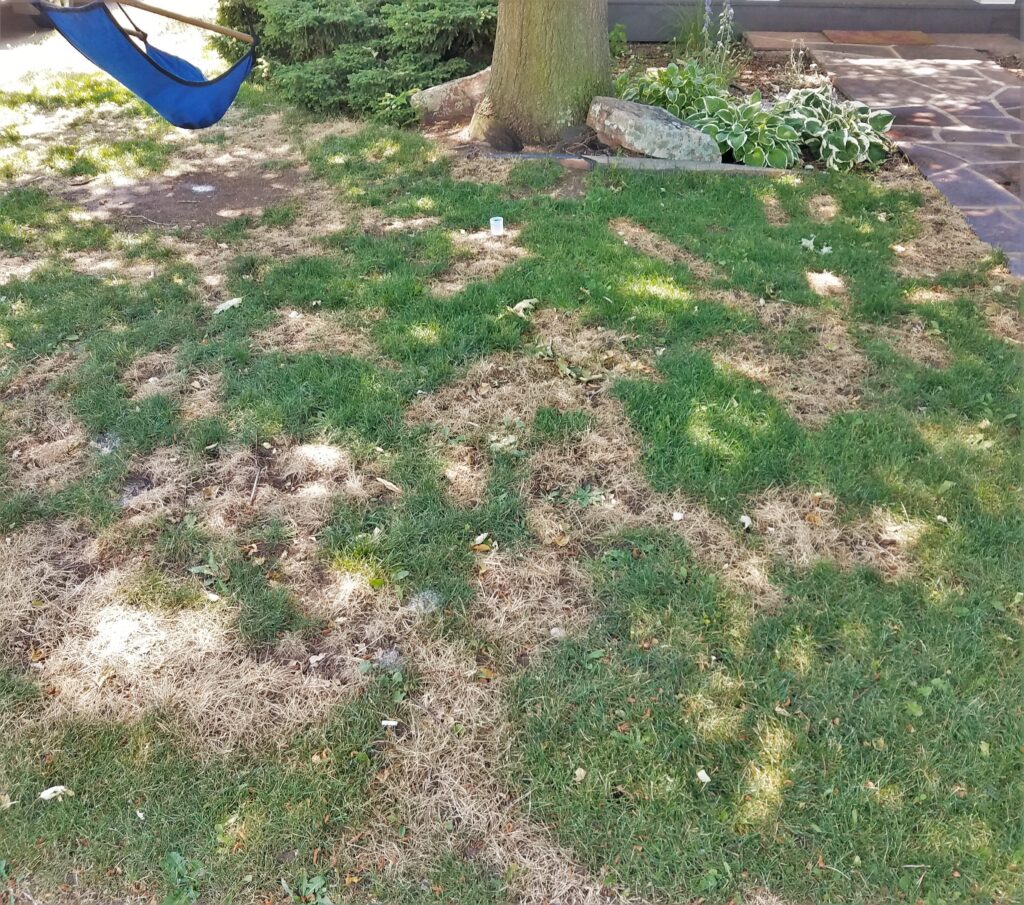
Brown Patch Lawn Fungus
Caused by Humidity / Moisture
Brown patch is generally a significant issue for lawns in humid climates. However, the low humidity in Colorado helps prevent this common lawn disease, which is why it is rarely seen in the state. When brown patch does occur in Colorado, it typically affects very shady areas that are being excessively watered. The grass types most susceptible to brown patch include perennial ryegrass, tall fescue, and bentgrass. Occasionally, Kentucky bluegrass can also be affected during mid- to late summer, especially during extended periods of high temperature and humidity.
Uncommon in Colorado
In Colorado, brown patch can be effectively managed by following the 1-2-3-2-1 lawn watering technique, performing core aeration, and implementing proper organic fertilization. The use of fungicides or other lawn chemicals is generally unnecessary, as the low humidity in Colorado is beneficial in preventing brown patch outbreaks.
Dog Vomit Slime Mold
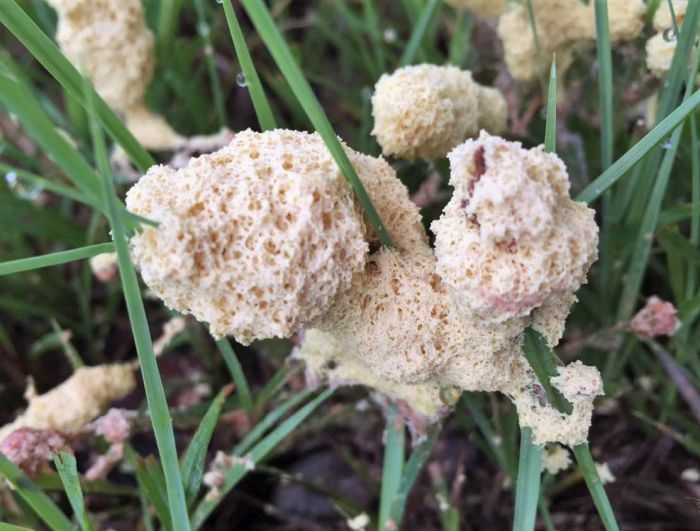
Dog Vomit Slime Molds on Grass
The Coolest Name for a Lawn Problem
Foamy patches known as slime molds may suddenly appear on lawns or around mulch areas. These slime molds are common after rainy periods, especially in warm and humid conditions. They come in various colors, including white, gray, yellow, purple, orange, and brown. Some people liken their appearance to vomit from dogs or other animals, which is likely how the term “dog vomit slime mold” originated.
Ugly Fungi
Slime molds are a group of fast-growing fungi that are generally more unsightly than harmful. They do not damage the lawn and may actually benefit plants by consuming potential pathogens and bacteria that could harm them. Additionally, slime molds are not dangerous to humans or animals.
Unsightly but Harmless
Chemical controls or fungicides are unnecessary and largely ineffective. To prevent the development of slime molds, it is helpful to water according to the 1-2-3-2-1 lawn watering technique. If slime molds do appear, they can be managed by waiting for the area to dry, then raking or mowing the affected spots. Alternatively, using a hose to wash away the slime mold with a strong stream of water is also an effective way to control their presence.
Fairy Ring
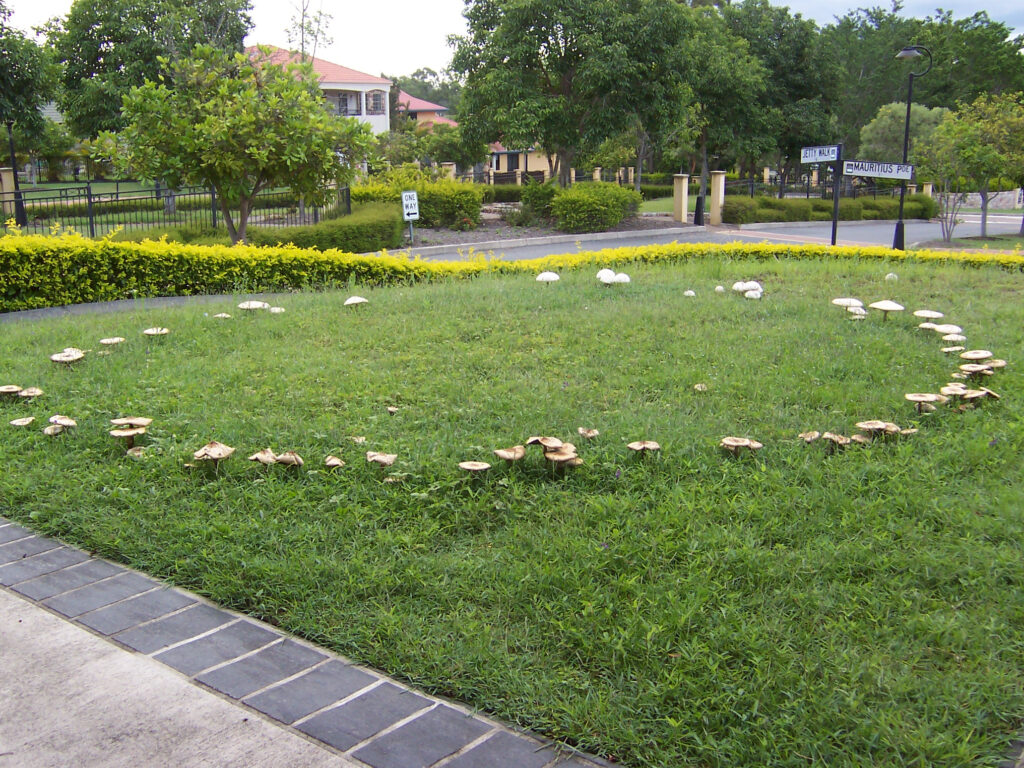
Fairy Ring Lawn Fungus
Circle of Mushroom
Fairy rings are created by a group of soil-dwelling fungi known as basidiomycetes. In lawns, they present as dark green circles that can range in size from a few inches to over 200 feet in diameter. The dark-colored rings of grass result from the release of nitrogen and other nutrients by the fungi as they feed on decaying organic matter in the soil. It is common to see a circle of mushrooms growing around the edge of the affected area.
Thatch Problem
Fairy rings are a sign of thatch problems in a lawn. Thatch develops when a lawn is not watered properly. Fairy rings can grow at a rate of 6 to 24 inches annually, depending on environmental conditions. They are not very common in Colorado because they are less prevalent in clay soils; instead, they thrive in sandy soils that are low in water and nutrients.
Fix the Soil, Fix the Problem
The best treatment for fair rings in a lawn are to perform a double lawn aeration, stimulate beneficial microbial activity in the soil with organic fertilizer treatments, humate soil conditioner applications, and watering the lawn according to the 1-2-3-2-1 lawn watering technique. Fungicide or chemical treatments are not necessary in preventing and treating fairy rings.
Necrotic Ring Spot
Fusarium Blight / Necrotic Ring Spot
Severe Overwatering of the Lawn
Fusarium Blight, also known as Necrotic Ring Spot, is a disease caused by the fungi Fusarium roseum and F. tricinctum. It primarily affects cool-season grasses, particularly bluegrass lawns. This condition is a clear indication of prolonged overwatering of the lawn.
Irregular Rings
The fungus causes necrosis in the roots, resulting in doughnut-shaped rings that can measure up to 3 feet in diameter. The center of these rings typically contains healthy green grass, creating a distinctive frog-eyed pattern in the affected area. This unique appearance is why some people refer to it as the frog-eye fungus.
Caused by Severe Overwatering
Fusarium blight does not appear in a lawn overnight; it is caused by excessive overwatering for a long period of time, sometimes months, and is a clear indication of severely degraded soil. Repairing a lawn affected by severe fusarium blight can take between one to two years. The first step is to adjust the watering schedule by using the 1-2-3-2-1 lawn watering technique. Next, rebuild the microbial population in the soil by employing a combination of core aeration, high-quality organic fertilizers, and humate soil conditioner applications. If the blight is severe we do recommend compost top dressing applications to speed up the recovery of the soil.
Do Not Apply a Fungicide
It is important to note that fungicides should never be applied to a lawn with fusarium blight, as they can hinder the recovery process.
Glyphosate Damage
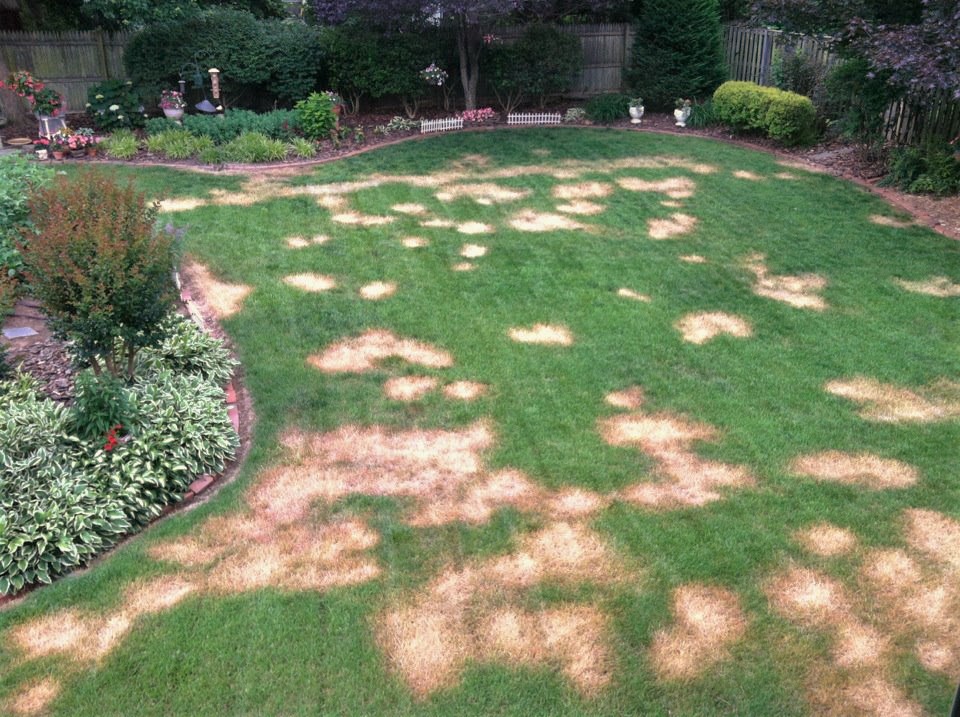
Glyphosate Damage to Grass
Homeowner Caused “Disease”
Is there a new exotic disease affecting lawns, or do these so-called “exotic diseases” often have simpler explanations? The photo to the left illustrates why lawn care should generally be left to professional yard care companies.
Spot Sprayed Weeds with Glyphosate
One common issue we encounter is glyphosate damage in lawns. Here’s an example from one of our clients. This homeowner was dealing with weeds in their lawn, and in an attempt to help, their son grabbed a weed killer from the garage and decided to spot spray all the weeds. About ten days later, the homeowner noticed strange circles forming in the grass.
Can’t Figure Out What is Harming Your Lawn?
Uncertain of what was causing the grass to die, they called us, convinced they had a sudden lawn disease. When we arrived, it quickly became clear that this was not a disease we had seen before.
Expert Diagnosis
We informed them that the dead patches were likely the result of a chemical application on the lawn. The homeowner insisted that no such treatment had been done. We then asked if anyone in the household had used Roundup to spot spray the lawn. The homeowner firmly replied, “Absolutely not!”
We Were Right
A few days later, they called us back to reveal that their son had admitted to spot spraying Roundup on the weeds. Oops!
Melting Out
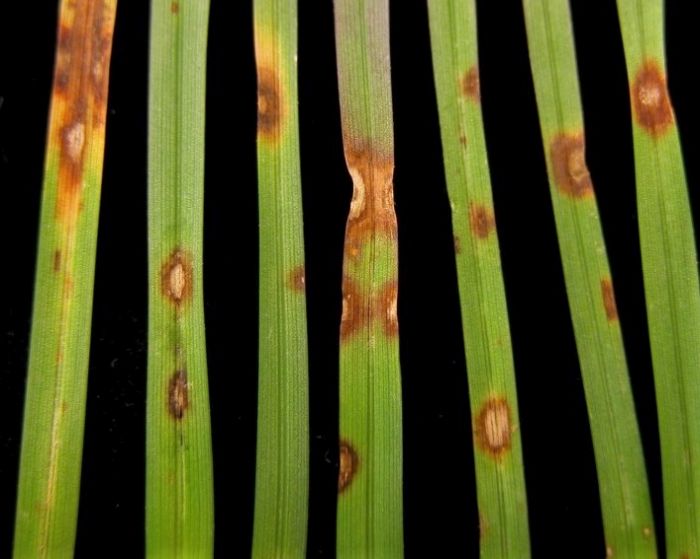
Melting Out Lawn Disease
Caused by Too Much Water
Melting Out disease is sometimes called leaf spot. This problem occurs in lawns that are stressed from excessive applications of chemical nitrogen fertilizer, improper lawn watering, and very short lawn mowing height. Two separate fungi cause the lawn discoloration, but, because the diseases usually occur together, they’re considered a single disease complex by experts.
Symptoms
Leaf spot symptoms include very small, purple or lack spots on individual leaf blades. The elliptical spots may be surrounded by a purple border. Tissue in the center of the spot often dies and turns a straw color. If a disease extends across the leaf, the blades wither and die.
Older Lawns Are Susceptible
Leaf spot is more common on lawns that were seeded or sodded prior to 1980, because the bluegrass varieties used during that time had relatively poor resistance to leaf spot. Newer bluegrass varieties are very resistant to leaf spot. Some lower quality bluegrass varieties sold in “big-box” stores are susceptible to this disease and should be avoided. Older lawns suffering from this disease should be seeded with high quality seed varieties instead of being treated with fungicides.
Proper Lawn Watering
Preventing this disease is easy if the lawn is being care for with high quality organic fertilizers and organic weed controls, is being mowed tall and watered according to the 1-2-3-2-1 lawn watering technique.
Sprinkler Head Coverage
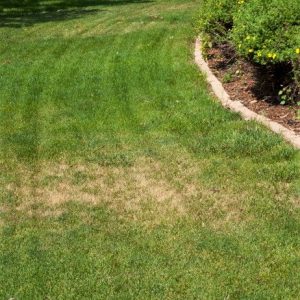
Poor Sprinkler Coverage
Not a Lawn Disease
Improperly adjusted sprinkler heads that leave large gaps in watering lawns are among the biggest lawn care problems in Colorado. Approximately 60% of brown spots in lawns are caused by inadequate sprinkler coverage.
Spots Appear in the Summer
Brown spots tend to appear during the hot summer months of June, July, and August, as well as during prolonged periods of drought. Many homeowners mistakenly assume that a brown spot in the lawn is due to disease or fungus; however, in most cases, these brown spots are related to sprinkler heads that are blocked by plants, malfunctioning, or incorrectly adjusted.
Fixing the Problem
Recovering a brown spot caused by poor sprinkler coverage is quite simple. First, adjust or repair the sprinkler head to ensure proper coverage. Then, water the affected area for three consecutive days, followed by the 1-2-3-2-1 lawn watering technique. If the sprinkler system cannot adequately water the area, using a hose with a sprinkler head for hand watering will effectively address the dry spot.
Powdery Mildew
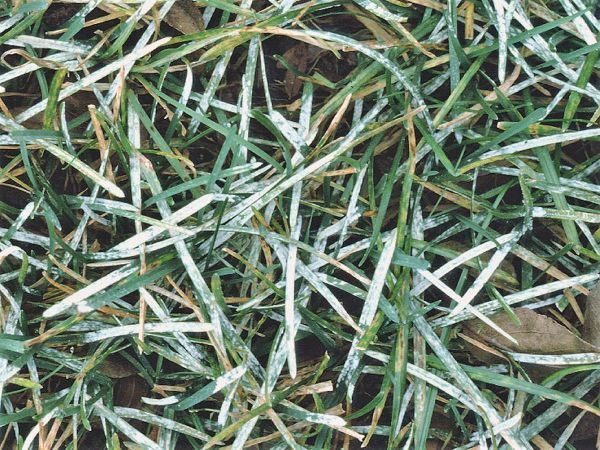
Powdery Mildew on Grass
Humidity and Lack of Air Circulation
Powdery mildew in lawns typically occurs when grass is growing in areas with poor air circulation. This minor lawn fungus begins as small, light spots on the blades of grass. As the condition progresses, nearly the entire blade will turn white, resembling a lawn dusted with talcum powder.
Rare in Colorado
Powdery mildew thrives in shady locations that have limited air movement. In Colorado’s dry climate, lawns that experience recurring outbreaks of powdery mildew may indicate that the watering routine is not aligned with the 1-2-3-2-1 technique.
Air Flow Improvement Helps
To enhance air circulation and sunlight exposure, consider pruning trees that contribute to shade. If a lawn area remains consistently shady, you might want to cover it with attractive mulch. The space beneath a tree is ideal for creating a cozy retreat with garden seating and potted shade plants.
Not a Major Problem
Fortunately, powdery mildew does not damage the grass’s crown, so it is unnecessary to treat the lawn with fungicides or chemical treatments. Improving airflow and adhering to the 1-2-3-2-1 lawn watering technique are the best strategies for preventing powdery mildew.
Power Rake Damage

Power Rake Damage to Grass
Do Not Power Rake After the Grass Has Already Greened Up
Power raking or thatching a lawn after the grass had started to green up can cause serious damage.
Power Raking Usually Isn’t Necessary
Most lawns do not need to be power raked because they do not have an excessive thatch layer. Many lawn care companies do not understand what power raking a lawn accomplishes and they offer this unnecessary lawn care service to customers. Damage to the lawn can occur if the power rake is performed after the lawn has started to green up for the season.
Fix the Thatch
If a lawn is suffering from an excessive thatch layer a better method for controlling the thatch problem is to stimulate beneficial microbial activity in the soil. The reason that the thatch is accumulating is because there is an absence of microorganisms that feed on the organic matter. Power raking a lawn is only necessary in the most extreme cases.
March is Power Rake Season
Lawn damage caused from a power raking or thatching that was performed too late in the season will usually take 1-3 months to recover. Proper lawn mowing, using high quality organic fertilizers, proper lawn watering, and core aeration will help the lawn recover faster. Always consult with a professional lawn care company prior to power raking a lawn.
Rust Lawn Disease

Rust on Grass
Poor Air Circulation and Humidity
Rust in lawns typically occurs when grass is growing in areas with poor air circulation. This minor lawn fungus starts as small orange powdery spores known as rust, which can appear on grass blades. In Colorado, rust is relatively uncommon due to the dry climate; however, it may surface after periods of rainy or humid weather. It is often noticed when orange pustules rub off on shoes, clothing, or feet, making it easy to track indoors.
Cool Nights and Dew
Ideal conditions for rust development include cool nights with heavy dew, along with light and frequent rainfall or irrigation. To help prevent rust from forming in grass, it’s beneficial to follow the 1-2-3-2-1 lawn watering technique.
Not a Major Concern
While rust usually does not cause serious damage to lawns, it can weaken turf grasses, making them more vulnerable to heat stress, drought, and other lawn diseases. The best way to prevent and manage rust is through proper cultural practices. Lawns that are watered according to the 1-2-3-2-1 technique, mowed to a height of three inches or taller, and fertilized with high-quality organic fertilizers rarely experience significant rust issues. Additionally, ensuring good airflow and adequate sunlight is crucial in preventing rust growth on grass. Using fungicides or chemicals to control rust in lawns is generally unnecessary.
Tree Leaf Damage
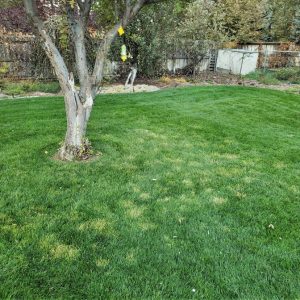
Tree Leaf Damage
Grass Blocked from the Sun
The lawn exhibits an unusual spotted pattern that initially appears to indicate a strange or exotic disease. However, the cause of this discoloration is not related to the grass itself; rather, it is due to the tree. During the fall, the tree dropped a significant number of leaves, and the homeowner allowed these leaves to remain on the grass for three weeks without removal. This accumulation of leaves blocked sunlight from reaching the grass, resulting in brown patches.
Fast Recovery
It is essential to rake or mow the leaves that are sitting on the lawn. The grass will recover as soon as it receives adequate sunlight, but full recovery may take a few weeks.
What is the Best Way to Prevent a Lawn Disease?
Sound Cultural Practices are The Key to a Healthy Lawn!
Build a Living Soil
The key to treating and preventing lawn fungus problems lies in creating an environment that fosters a diverse population of microorganisms, known as living soil. When the soil is healthy, the lawn’s ecosystem is balanced, resulting in a vibrant appearance.
Disease Resistant Grass Types
However, it’s important to note that all species of plants are vulnerable to disease infestations. Fungi are responsible for most grass diseases. Turf grasses, which are typically a mono-culture made up of similar species with a uniform genetic makeup, are particularly susceptible to these diseases. During stressful conditions such as heat, drought, and poor maintenance practices, pathogens (diseases or fungi) can invade the turf grass. If the environmental conditions favor the fungus, these grass diseases can become destructive and spread rapidly.
Cultural Practices
In Colorado, the most effective way to control grass diseases is by adhering to proper lawn care practices. This includes using appropriate mowing techniques, applying organic lawn fertilizers, watering deeply and infrequently, performing core aeration, and avoiding all lawn chemicals.
Necrotic Ring Spot
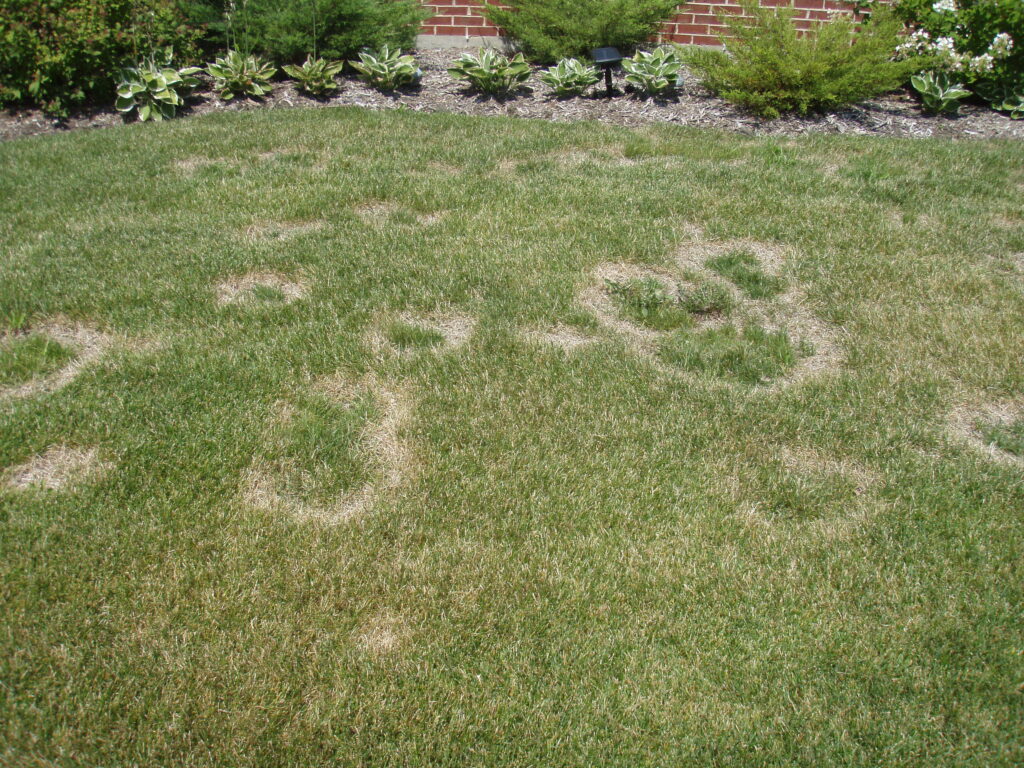
Curing a Lawn Disease without Fungicides?
Most Lawn Diseases are Easily Preventable
Did you know that every lawn disease in Colorado is preventable by following proper lawn watering techniques? By using the 1-2-3-2-1 lawn watering method, you can safeguard your grass from the most common lawn issues. Many lawn diseases stem from improper care, such as an improperly programmed irrigation controller, mowing the grass too short, and using chemical fertilizers.
We Can Help!
If you’re dealing with a lawn fungus or disease, we are here to help. Our experienced team will create a tailored plan that not only identifies the root cause of the problem but also effectively treats the disease. Our long-lasting lawn fungus treatment services typically involve simple yet crucial adjustments, like optimizing your mowing height and adjusting your watering schedule. Unlike other lawn care companies, we don’t rely on fungicides, which can often worsen the situation.
Why You Shouldn’t Use a Fungicide
Before you consider using fungicides, reach out to our office to book a visit from one of our skilled lawn care technicians for a comprehensive disease diagnosis. While we do charge for this valuable service, we often waive all or part of the fee if you implement our recommended solutions. Remember, the key to restoring your lawn is accurately diagnosing its issues to tackle the root cause effectively. Don’t wait—give your lawn the care it deserves!
Organo-Lawn is your local lawn care expert and can explain in Layman’s terms what is causing the lawn to have brown spots. Call today to talk to one of our professional lawn care technicians.
Lawn Fungus Treatment Experts
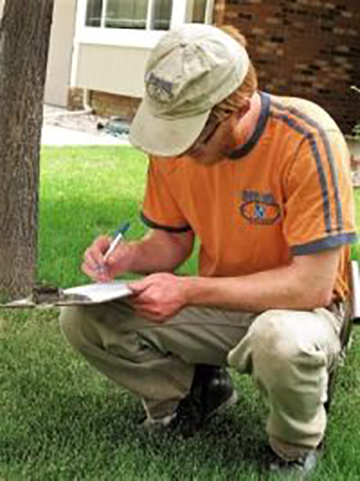
Lawn Disease and Fungus Treatment Services of Colorado
(303) 499-2000 Boulder or (970) 225-9425 Fort Collins.
Lawn Disease Treatment Services FAQs
What are the Most Common Lawn Diseases in Colorado Lawns?
Necrotic Ring Spot Fungus and Ascochyta Leaf Blight – The most common Colorado lawn fungus is called Necrotic Ring Spot. This lawn disease is a perennial soil borne lawn fungus that affects Kentucky bluegrass and is caused by severe over watering of the lawn for a long period of time. Ascochyta Leaf Blight is another lawn problem that affects lawns that have shallow digging grass roots.
Ascochyta Leaf Blight
How to Treat Lawn Diseases Without Using Chemicals?
Following the 1-2-3-2-1 lawn watering recommendations is one of the most important steps to preventing and curing lawn diseases. Improper lawn watering practices are the main cause of 99% of lawn diseases. The most effective defense to pathogen infestations is to maintain proper lawn care cultural practices, such as proper lawn mowing techniques, the use of organic lawn fertilizers instead of chemical lawn fertilizers, proper lawn watering (deep and infrequent watering), core aeration, and avoiding the use of chemical pesticides at all times.
Additional Lawn Fungus FAQs
In Colorado, the most common fungus problems we see are:
Ascochyta Leaf spot or Dollar Spot: Small, round patches of bleached grass caused by improper lawn watering techniques which cause the grass roots to stay shallow in the soil.
Necrotic Ring Spot: Circular rings of dark green or dead grass caused by severe overwatering of the lawn for a long period of time.
Brown patches could be due to several factors, including lawn fungus, dry weather, or over-fertilizing. The first step is identifying the problem.
Over-fertilizing with synthetic fertilizers can do more harm than good. At Organo-Lawn, we only use organic, naturally slow-release fertilizers, which will be beneficial when you have a fungus, by stimulating beneficial microbe growth in the soil, to help naturally combat the disease.
Lawn fungus thrives in humid, wet, and stressed conditions. Overwatering, poor drainage, excessive thatch, compacted soil, and improper mowing height can create an environment where fungal diseases spread easily.

